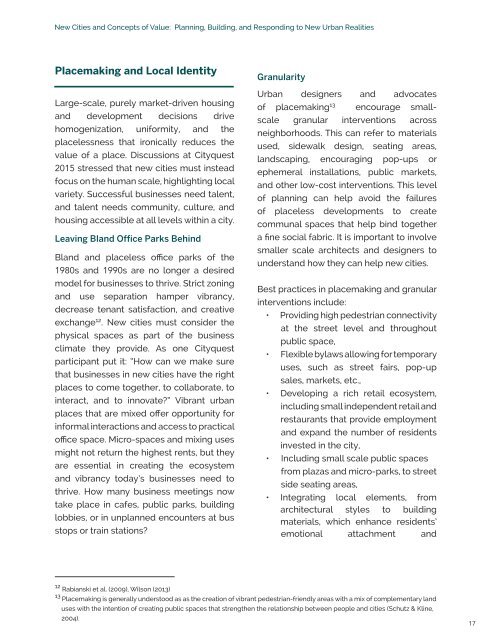New Cities and Concepts of Value
PDF-New-Cities-and-Concepts-of-Value-CityquestKAECForum2015
PDF-New-Cities-and-Concepts-of-Value-CityquestKAECForum2015
You also want an ePaper? Increase the reach of your titles
YUMPU automatically turns print PDFs into web optimized ePapers that Google loves.
<strong>New</strong> <strong>Cities</strong> <strong>and</strong> <strong>Concepts</strong> <strong>of</strong> <strong>Value</strong>: Planning, Building, <strong>and</strong> Responding to <strong>New</strong> Urban Realities<br />
Placemaking <strong>and</strong> Local Identity<br />
Large-scale, purely market-driven housing<br />
<strong>and</strong> development decisions drive<br />
homogenization, uniformity, <strong>and</strong> the<br />
placelessness that ironically reduces the<br />
value <strong>of</strong> a place. Discussions at Cityquest<br />
2015 stressed that new cities must instead<br />
focus on the human scale, highlighting local<br />
variety. Successful businesses need talent,<br />
<strong>and</strong> talent needs community, culture, <strong>and</strong><br />
housing accessible at all levels within a city.<br />
Leaving Bl<strong>and</strong> Office Parks Behind<br />
Bl<strong>and</strong> <strong>and</strong> placeless <strong>of</strong>fice parks <strong>of</strong> the<br />
1980s <strong>and</strong> 1990s are no longer a desired<br />
model for businesses to thrive. Strict zoning<br />
<strong>and</strong> use separation hamper vibrancy,<br />
decrease tenant satisfaction, <strong>and</strong> creative<br />
exchange 12 . <strong>New</strong> cities must consider the<br />
physical spaces as part <strong>of</strong> the business<br />
climate they provide. As one Cityquest<br />
participant put it: “How can we make sure<br />
that businesses in new cities have the right<br />
places to come together, to collaborate, to<br />
interact, <strong>and</strong> to innovate?” Vibrant urban<br />
places that are mixed <strong>of</strong>fer opportunity for<br />
informal interactions <strong>and</strong> access to practical<br />
<strong>of</strong>fice space. Micro-spaces <strong>and</strong> mixing uses<br />
might not return the highest rents, but they<br />
are essential in creating the ecosystem<br />
<strong>and</strong> vibrancy today’s businesses need to<br />
thrive. How many business meetings now<br />
take place in cafes, public parks, building<br />
lobbies, or in unplanned encounters at bus<br />
stops or train stations?<br />
Granularity<br />
Urban designers <strong>and</strong> advocates<br />
<strong>of</strong> placemaking 13 encourage smallscale<br />
granular interventions across<br />
neighborhoods. This can refer to materials<br />
used, sidewalk design, seating areas,<br />
l<strong>and</strong>scaping, encouraging pop-ups or<br />
ephemeral installations, public markets,<br />
<strong>and</strong> other low-cost interventions. This level<br />
<strong>of</strong> planning can help avoid the failures<br />
<strong>of</strong> placeless developments to create<br />
communal spaces that help bind together<br />
a fine social fabric. It is important to involve<br />
smaller scale architects <strong>and</strong> designers to<br />
underst<strong>and</strong> how they can help new cities.<br />
Best practices in placemaking <strong>and</strong> granular<br />
interventions include:<br />
• Providing high pedestrian connectivity<br />
at the street level <strong>and</strong> throughout<br />
public space,<br />
• Flexible bylaws allowing for temporary<br />
uses, such as street fairs, pop-up<br />
sales, markets, etc.,<br />
• Developing a rich retail ecosystem,<br />
including small independent retail <strong>and</strong><br />
restaurants that provide employment<br />
<strong>and</strong> exp<strong>and</strong> the number <strong>of</strong> residents<br />
invested in the city,<br />
• Including small scale public spaces<br />
from plazas <strong>and</strong> micro-parks, to street<br />
side seating areas,<br />
• Integrating local elements, from<br />
architectural styles to building<br />
materials, which enhance residents’<br />
emotional attachment <strong>and</strong><br />
12 Rabianski et al. (2009), Wilson (2013)<br />
13 Placemaking is generally understood as as the creation <strong>of</strong> vibrant pedestrian-friendly areas with a mix <strong>of</strong> complementary l<strong>and</strong><br />
uses with the intention <strong>of</strong> creating public spaces that strengthen the relationship between people <strong>and</strong> cities (Schutz & Kline,<br />
2004).<br />
17


